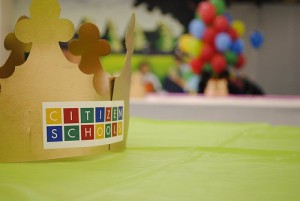Six Strategies for Helping Students with Behavior Challenges
George Ganzenmuller is a Second Year Teaching Fellow at the Edwards Middle School in Charlestown, MA
Before the first day of school, my principal was discussing the school-wide behavior management strategies we were implementing for the school year. As teachers quibbled about the rules not being strict enough, he made the statement that, “90% of kids are going to follow these rules without any trouble, 9% are going to show some defiance and 1% will openly defy the rules and become major behavior problems”. He went on to clarify that we have the systems in place to help guide the 9% back to the proper path. However, we have to get creative with the 1% and sometimes, the reality is, that no matter what we do, some kids aren’t going to respond.
Over the past two years, I’ve worked with students with learning disabilities and students with social, emotional and behavioral challenges. Coincidentally, or not, right in the thick of the 1%. It’s not a job for the easily insulted or easily fatigued. I’ve been told that I need to use proactive, that I’m a skinny punk and my mother didn't feed me enough (I’m 6’2, 190lbs… that one didn’t sting too much), that I’m a horrible teacher and I've even been called a F#$%-ing B*&%h (two days in a row, that was a rough week). But, I’ve also been told thank you, been called a favorite teacher, and have gotten heartfelt apology and thank you notes from kids.
It’s tough and you do have to get creative to get kids working hard and, more often than not, your creativity falls flat with no response. But, I have found a few successful strategies, which I’ll share now:
Give the Power Back: Last year, I had one 6th grader who had particular difficulty reading. So, in my math class, he needed help with word problems. Problem was he refused to accept my help when I went over to his desk to read the problems. He would throw a tantrum and say that he didn’t need help. I persisted for a couple days until I realized, the issue was a power struggle. He didn’t want to be dependent on me. So, I came up with a strategy - he would circle six problems to do for the day – three to do on his own and three that we would do together. We could do it in the order that he chose and he would let me know when he was ready for our problems. The turnaround was remarkable; instead of pushing back when I tried to help him, he became excited everyday for the problems that we would do together. Sometimes kids need to have a certain amount of control over what they're doing in order to buy in.
A Little Help from their Friends: It’s November and I’m still struggling to come up with ideas to keep one of my students in class. He is a very energetic boy who loves to dance, sing, draw and interrupt the teacher. He can often be found loudly starting arguments with classmates and disrupting the learning process. Often, I unfortunately find myself forced to send him out of class for the sake of the other students’ learning. Sadly, he misses out on much needed learning time (he struggles with basic math functions in the 6th grade). I was at my wit’s end when it came to me – why not cater to his interests. We developed a system whereby if he could do three things in class (1. No negative comments 2. Try his hardest on all activities 3. Follow all instructions the first time), he can earn the right to draw a picture of The Notorious B.I.G., his favorite rapper and his favorite topic of discussion. I was shocked at how quickly he bought in. I’ve used the Biggie system twice and it has been a 2 for 2 success - a quietly engaged young man who has been able to stay in class and participate positively. Of course, this strategy won't work forever, but creatively coming up with incentives that students actually want to earn always seems to work for a little while at least.
Stress Balls: It may sound silly, but easily angered students really benefit from having something as simple as a stress ball to take their anger out on (squeeze, not throw – very important distinction) when they’re frustrated.
Individual Rewards: My students earn ‘value stars’ when they exhibit the values that Citizen Schoolsaims to teach them (Respect, Courage, Tenacity, Pride, Teamwork) and each time they earn a star I mark it on our visual tracker. At the end of two weeks, the student with the most stars earns an individual award.
Group Rewards: In addition to working for stars for themselves, each time a student earns a star our team (class) gets a point. When we reach 100 points we earn a class party.
Personal Connection: Perhaps the most important and effective way to help children with behavior challenges develop the skills they need to succeed in the classroom is to cultivate a personal connection with them and show them that you truly care about them. Ask them about their hobbies, interests, weekends, families and anything else you can think of. Many times, students with emotional and social challenges are receiving negative messages from the adults in their lives and even having one adult who believes in them can help them muster up the willpower to try their hardest in school.
What strategies can you share for serving students with behavior challenges?

